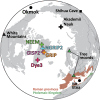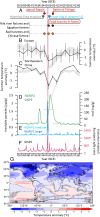Extreme climate after massive eruption of Alaska's Okmok volcano in 43 BCE and effects on the late Roman Republic and Ptolemaic Kingdom
- PMID: 32571905
- PMCID: PMC7354934
- DOI: 10.1073/pnas.2002722117
Extreme climate after massive eruption of Alaska's Okmok volcano in 43 BCE and effects on the late Roman Republic and Ptolemaic Kingdom
Abstract
The assassination of Julius Caesar in 44 BCE triggered a power struggle that ultimately ended the Roman Republic and, eventually, the Ptolemaic Kingdom, leading to the rise of the Roman Empire. Climate proxies and written documents indicate that this struggle occurred during a period of unusually inclement weather, famine, and disease in the Mediterranean region; historians have previously speculated that a large volcanic eruption of unknown origin was the most likely cause. Here we show using well-dated volcanic fallout records in six Arctic ice cores that one of the largest volcanic eruptions of the past 2,500 y occurred in early 43 BCE, with distinct geochemistry of tephra deposited during the event identifying the Okmok volcano in Alaska as the source. Climate proxy records show that 43 and 42 BCE were among the coldest years of recent millennia in the Northern Hemisphere at the start of one of the coldest decades. Earth system modeling suggests that radiative forcing from this massive, high-latitude eruption led to pronounced changes in hydroclimate, including seasonal temperatures in specific Mediterranean regions as much as 7 °C below normal during the 2 y period following the eruption and unusually wet conditions. While it is difficult to establish direct causal linkages to thinly documented historical events, the wet and very cold conditions from this massive eruption on the opposite side of Earth probably resulted in crop failures, famine, and disease, exacerbating social unrest and contributing to political realignments throughout the Mediterranean region at this critical juncture of Western civilization.
Keywords: Okmok; Rome; climate forcing; ice core; volcano.
Conflict of interest statement
The authors declare no competing interest.
Figures




Comment in
-
The sun of Rome is set! Volcanic dust veils and their political fallout.Proc Natl Acad Sci U S A. 2020 Jul 28;117(30):17470-17472. doi: 10.1073/pnas.2011054117. Epub 2020 Jul 8. Proc Natl Acad Sci U S A. 2020. PMID: 32641507 Free PMC article. No abstract available.
-
Reply to Strunz and Braeckel: Agricultural failures logically link historical events to extreme climate following the 43 BCE Okmok eruption.Proc Natl Acad Sci U S A. 2020 Dec 22;117(51):32209-32210. doi: 10.1073/pnas.2019906117. Epub 2020 Nov 24. Proc Natl Acad Sci U S A. 2020. PMID: 33234572 Free PMC article. No abstract available.
-
Did volcano eruptions alter the trajectories of the Roman Republic and the Ptolemaic Kingdom? Moving beyond black-box determinism.Proc Natl Acad Sci U S A. 2020 Dec 22;117(51):32207-32208. doi: 10.1073/pnas.2019022117. Epub 2020 Nov 24. Proc Natl Acad Sci U S A. 2020. PMID: 33234573 Free PMC article. No abstract available.
References
-
- Ramsey J., Licht A., The Comet of 44 B.C. and Caesar’s Funeral Games, Blank D., Ed. (American Philological Association, Scholars Press, Atlanta, GA, 1997).
-
- Stothers R., Rampino M., Volcanic eruptions in the Mediterranean before A.D. 630 from written and archaeological sources. J. Geophys. Res. 88, 6357–6371 (1983).
-
- Forsyth P., In the wake of Etna, 44 B.C. Class. Antiq. 7, 49–57 (1988).
-
- Thompson D., Cleopatra queen of Egypt. Ancient Hist. 17, 11–15 (2018).
Publication types
MeSH terms
LinkOut - more resources
Full Text Sources
Medical
Miscellaneous

